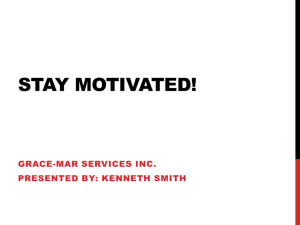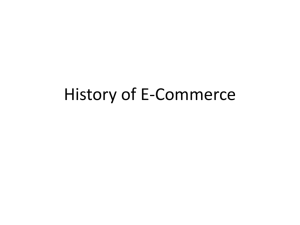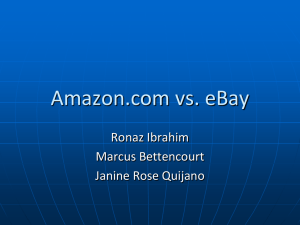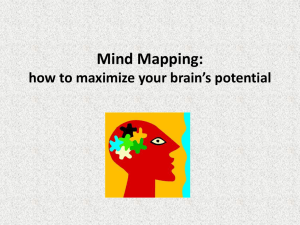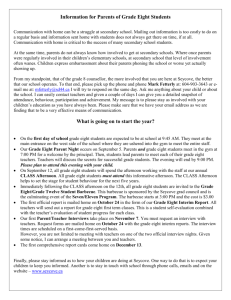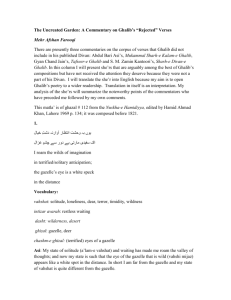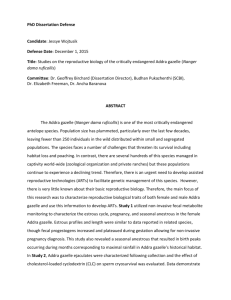Mac: new
advertisement
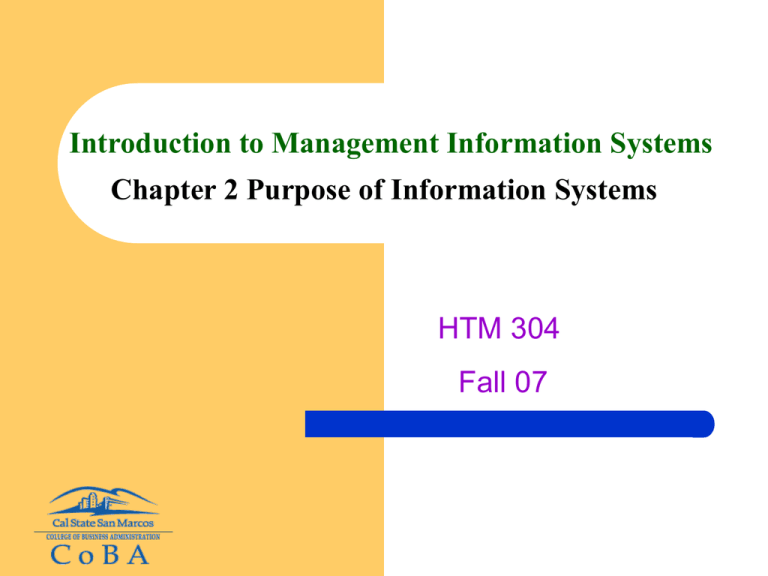
Introduction to Management Information Systems Chapter 2 Purpose of Information Systems HTM 304 Fall 07 Learning Objectives Understand the three purposes of information systems Know the eight principles of competitive advantage Understand how information systems create competitive advantage Define problem Recognize that different information systems are needed to solve different problem definitions Know the characteristics of decision making Understand how information systems facilitate decision making 2 Review Definition of management information systems Process of information system development Focus of this chapter 3 Three main purposes of information systems To gain competitive advantage To solve problems To assist in decision making 4 1. Competitive Advantage There is an old African proverb … 5 Every morning a gazelle wakes up and knows it will have to run faster than the fastest lion 6 Every morning a lion wakes up and knows it will have to run faster than the slowest gazelle 7 But lion or gazelle, one thing is sure: when the day begins, you’d better start running 8 Competitive Advantages Definition – An advantage over competitors in some measure such as cost, quality, or speed, leads to control of a market and to larger- than average profits. 9 Market Competition: Porter’s Five Forces Model 10 Internet has changed the five forces Read the assignment and choose a verb for each blank: (try not to use the same words) 1. Internet __________ traditional barriers to entry. 2. Internet ______ the intensity of competition among existing competitors. 3. Internet ______ the bargaining power of suppliers. 4. Internet ______ the bargaining power of customers. 5. Internet ______ the existence of substitute products and services. 11 Eight Principles of Competitive Advantage Create & improve products Raise barriers Increase trust & cut costs 12 Information System may help in all the eight areas. Case: IS Creates & Enhances Amazon Mission To be Earth's most customer-centric company where people can find and discover anything they want to buy online Technology innovation drives Amazon growth Personalized shopping experience Book discovery through Search Inside the Book 1-Click® Shopping Gold Box New Deals Community features like Listmania and Wish Lists Shares storefront technology via Web services Technologies used to manage logistics and reduce costs 13 Personalized Shopping 14 Personal Address Book Locks In 15 1-click check out 16 Gold Box New Deals 17 Custom Book Recommendations • Uses IS to compare your shopping preferences to millions of others for recommendations 18 Strategic Alliance 19 Amazon’s Competitive Advantages 1. Create new product or service? 2. Enhance products or services? 3. Differentiate products or services? 4. Lock in customers and buyers? 5. Lock in suppliers? 6. Raise barriers to market entry? 7. Establish alliances? 8. Reduces costs 20 Be Careful Websites also provide product descriptions (+ Search inside the book) to better inform shoppers. Will this become a competitive advantage for the store? 21 2. Problem Solving Information Systems can be used for problem solving A Laptop Problem (page 30) Problem: a perceived difference between what is and what ought to be. Problem definition: defines the difference by describing both the current situation and the desired situation, e.g. the customer support representative do not have data about the prior call to best assist a customer Solution: 22 1. A CRM System to store customer information and all the interactions (Chapter 7) 2. Knowledge Management System to provide customer procedures to fix the laptops (Chapter 9) 3. A Manufacturing Quality-Control Information System to eliminate possible faulty laptops Other problems MIS in use 2-1 (page 32) Some other examples: Company directory updates. Company A has personnel transfer between department frequently. Jessie is the personnel in charge of publishing company phone books. Every 6 months, she send out a form to all the employees to see if they need to update their contact information. She then organize the changes into a new file and order new prints which will be available for distribution in 2 weeks Problem: – Costly publishing – phone books become obsolete quickly how IS can help? 23 3. Decision Making Information System can facilitate decision making Decision Levels Operational: day-to-day activities How many widgets should we order? e.g. Transaction processing systems (TPS) Managerial: allocation and utilization of resources. How much should we budget for computer hardware and software for department A? e.g. Management Information Systems (MIS) Strategic: broader-scope, organizational issues. Should we acquire company A? or allied with company B? e.g. 24 Executive information systems (EIS) Decision Process Structured Decision Well understood and accepted methods for decision making For example: Formula available to calculate when and how many units of material to order. Many formulae can be learnt from HTM 406. Unstructured Decision Implicit decisions. No agree-on decision making method. For example, predicting of the future economy and effect of strategic alliance. 25 Relationship Decision Process 26 Decision Type IS for Decision Making Use formula to produce results. Computers do the work. Computers help communication among people. People do the job. 27 Structured Decision Making Unstructured Decision Making Summary Three main purposes of IS (interrelated) Gain Competitive Advantages Solve Problems Facilitate Decision Marking Eight Principles of competitive advantages Explain what is a problem? Problem Definition Decision Types and Processes Relationships between decision types and processes Explain the concept of automated information systems and augmented information systems. 28 Opposing Forces: I don’t need a computer to do business G. Robinson Old Prints and Maps (Page 31a,b) 29 30 Suggested Blogging Topic Read the reflection guide and discuss: “what is your personal competitive advantage?” 31 Reading Assignment Read the opening story of Chapter 7 “Universal Electronics” (page 194 & 195) What do you think about the COOs answer? Are you satisfied with the answer? What do you learn from the answer? 32


